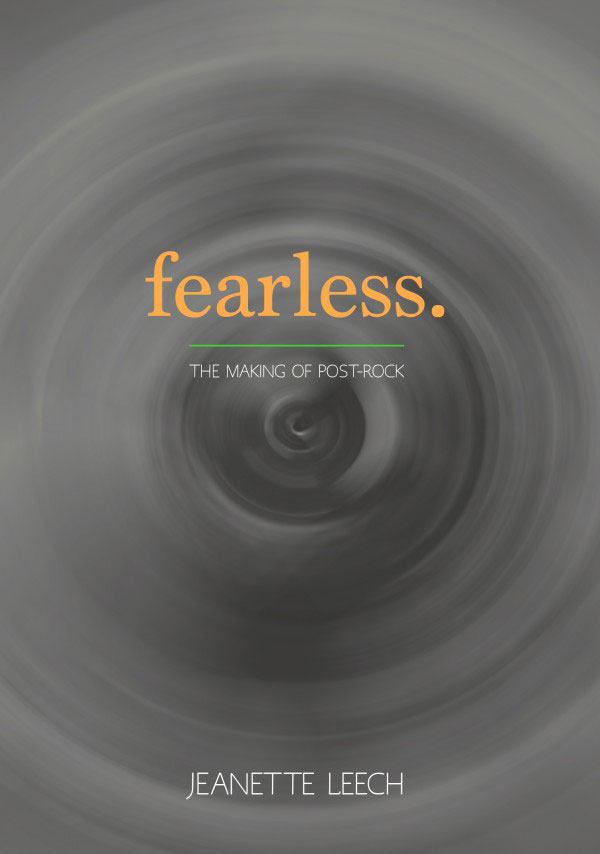
fearless. the making of post-rock, Jeanette Leech (£14.95, Jawbone)
By the time I’d finished the thirty pages of the first chapter of this book, I knew I was going to enjoy it. Jeanette Leech quickly lays a foundation for her book and the notion of post-rock, looking back to Ornette Coleman and then following threads of influence, difference and response through Lou Reed, AMM, the Red Crayola, progrock, Bark Psychosis, Tortoise, krautrock, Can, Amon Düül, Eno, Bowie, Joy Division, The Police, The Durutti Column, PiL, dub, Lee Perry, Scritti Politti, Dif Juz, Chorchozade and Sonic Youth, the last acting as a bridge and link to chapter 2 which moves to New York.
Leech is sharp-witted and intelligent, and writes a flowing, easy-to-read prose that facilitates the twists and turns and diversions she pursues throughout time and music. I love that eclectic gathering of music in chapter 1, love that it introduced me to a band I’ve never heard of (Chorchozade) and had me asking ‘really?’ and checking that Andy Summers really did play for Soft Machine. (Yup, he did.) I’ve also never heard anyone suggest that The Police, sans vocals, could be listened to as dubbed-out post-rock rather than old musos jumping on the new-wave bandwagon! (I’m not convinced.)
The diversity of music discussed, the web of musical, geographical and conceptual ideas is a constant throughout this amazing volume. The likes of the cacophonous Swans and the art-rock experiment of Sonic Youth are discussed alongside the quiet, drumless Hugo Largo, all in relation to Glenn Branca’s slabs of guitar compositions. The wonderful UT, who I remember seeing at Riverside Studios, show up too, as do the No Wave bands and, of course, Eno, who curated an LP of the movement. Somehow Public Enemy get included here, too – again, an interesting and provocative yet well-reasoned inclusion, which is also used to highlight the arrival of samplers in the music biz.
And so it continues, ducking and diving through the music, all the way through to the early 2000s, by which time, Leech argues, the term ‘post-rock’ no longer means anything. If at times I found the pages devoted to the likes of My Bloody Valentine and A.R. Kane not of much interest (I find both bands unlistenable), I enjoyed reading about Talk Talk, David Sylvian, Moonshake, Seefeel and Tortoise as well as many other bands I missed hearing at the time. Again, the points of connection are clearly made, across genres, record labels, lines of influence and resistance.
Negatives? Beyond some bands I’d have liked to have seen in there (Dub Sex and Rip, Rig & Panic, for instance), there’s little downside to this volume. I’m surprised there are no links back to industrial and post-punk music (Nurse with Wound get a brief mention in relation to Stereolab), who seem clear predecessors to much of this this music, surprised that Leech mentions alt-folk as much as she does (but she is the author of a previous volume, Seasons They Change: The Story of Acid and Psychedelic Folk) and drum’n’bass so little, and genuinely appalled that the book ends, in a chapter focussed on the marvellous bands Sigur Ros, Godpseed You Black Emperor! and their associates, by devoting several pages to the musical abomination that is Radiohead.
However, that aside, fearless is a fascinating read as group after group tries to work their way around the obvious tropes of ‘rock’, deconstructing and reinventing it over and over again. Rhythm, texture, content, harmonics, the studio as an instrument, improvisation and editing, sampling, the nature of music and sound itself, are all questioned time and time again. Leech’s title is apt: these musicians were fearless, and in being so made some of the most interesting music at the end of the 20th century.
Rupert Loydell
